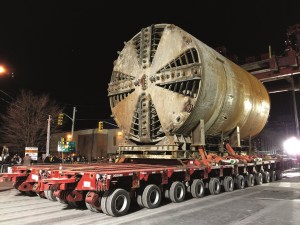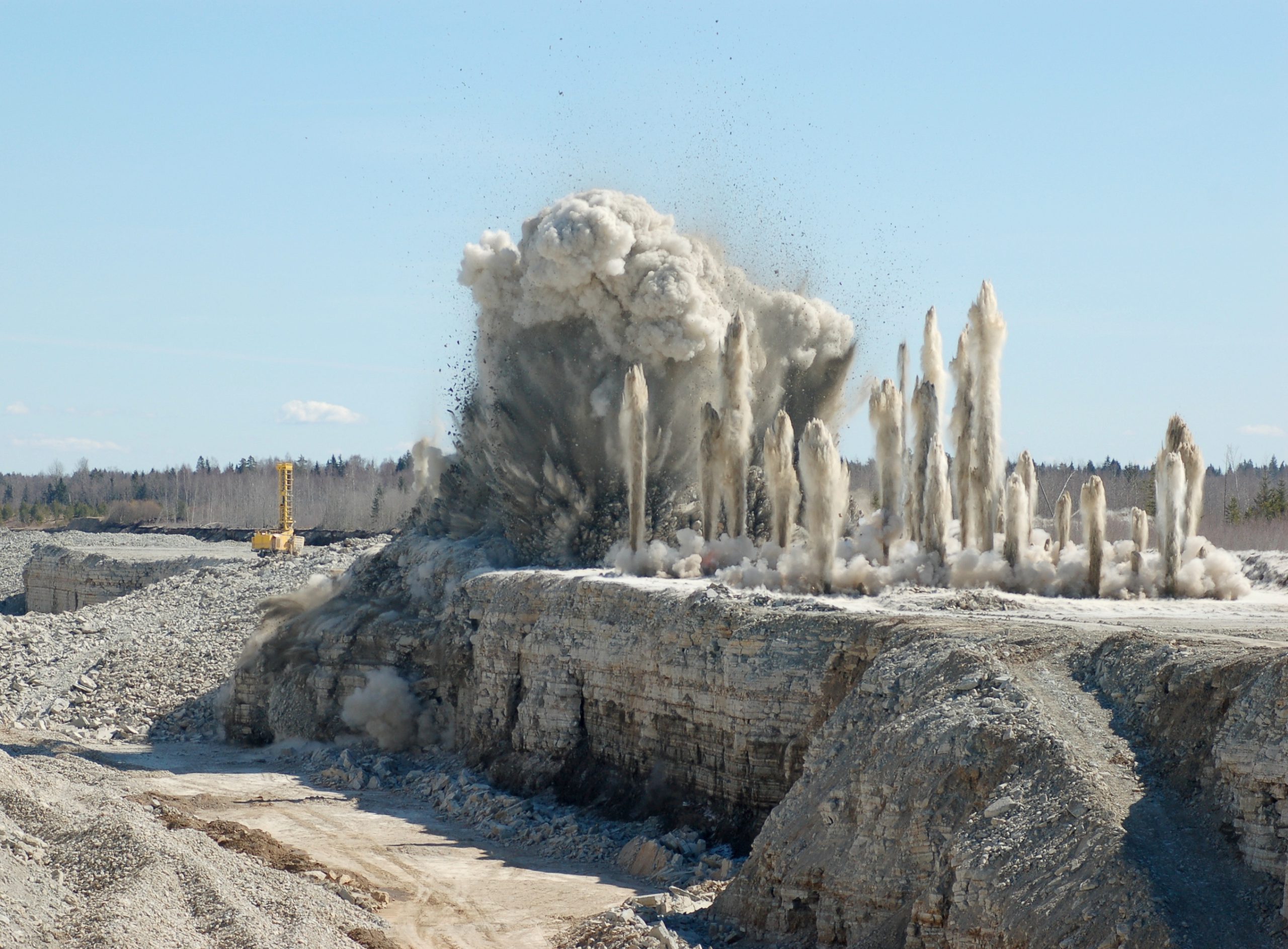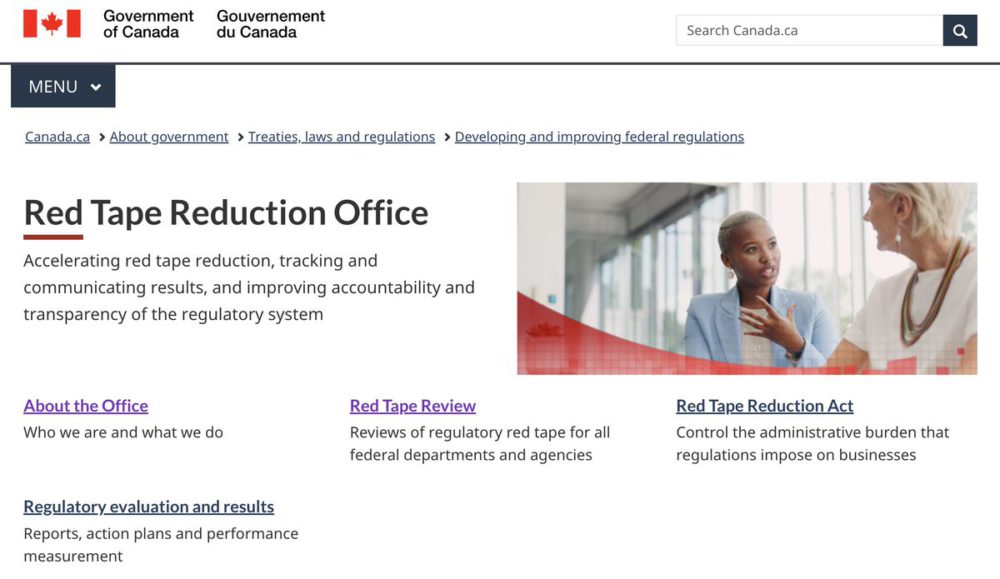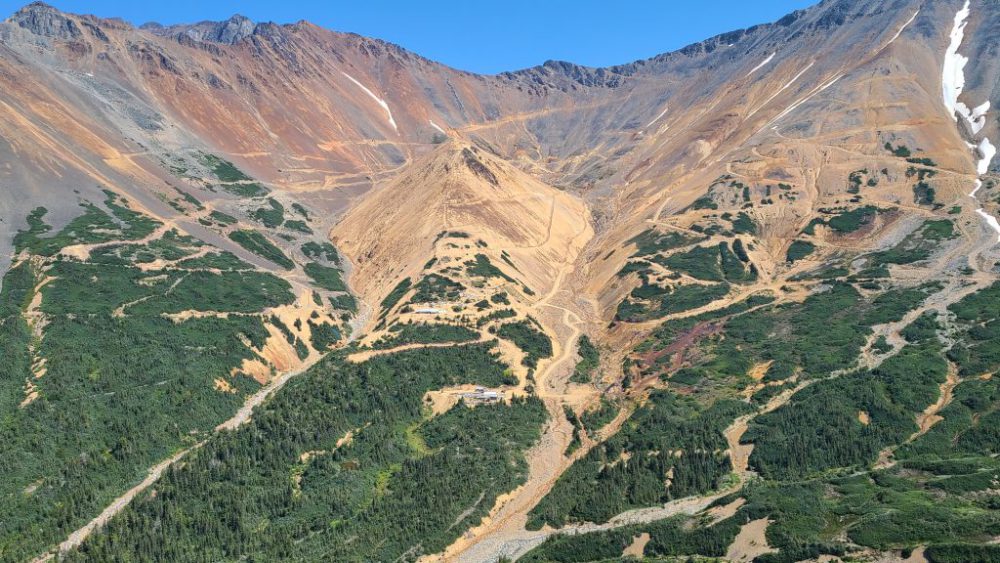Boring machines make tough Toronto tunnel job easier
Darrell Liebno calls Atlanta, Georgia, home, but the civil engineer hasn’t been there much for the past three years. He’s been in Toronto managing one of the larger underground infrastructure projects in the country– twin tunnels, 6.5-km long in the western portion of what will form part of the city’s 19-km Eglinton Crosstown light rapid transit line (LRT)
Regardless, that doesn’t mean the Eglinton job is simple, and it’s certainly not easy. And, it’s not a mining project, per se, but it requires the same skills and understanding of underground work as most mine construction.

Moving one of the four massive boring machines required an equally large flatbed truck to handle the extreme load.
“I’ve spent 25 years in the tunneling business and worked on subways, as well as water and sewage treatment tunnels, across North America,” says Liebno, a project manager with Obayashi Canada, one of four companies handling the Crosstown underground work. “Nothing we do is small or quiet, or light.
Community and public safety are huge issues when you’re working in dense urban environments.” Eglinton Avenue is a major, four-lane, east-west artery in midtown Toronto. Hundreds of small retail businesses line both sides of the thoroughfare. Thousands of people live in apartments above shops, or in apartment and condo towers.
High-rise commercial buildings soar above the intersection of Yonge Street and Eglinton. Furthermore, two north-south subway lines cross Eglinton. Yet, there have been so few street-level disruptions that most residents, retailers, office workers and subway riders are scarcely aware of the tunnels being excavated 16 to 20m below ground.
The $5.3-billion Eglinton Crosstown is part of 25-year, $50-billion transit and transportation plan designed to boost capacity and reduce congestion throughout the Greater Toronto and Hamilton Area.
Construction of the Crosstown LRT began in 2011, and is happening in three segments, with completion set for 2021.
Obayashi and its partners, Technicore Underground, Kenny Construction and Kenaiden Contracting, started near the intersection of Keele Street and Eglinton in June, 2013 and have been burrowing east toward Yonge Street.
In September, 2015, another consortium of contractors started work on twin tunnels at Laird Drive and have been proceeding west to Yonge–a distance of 3.km. A third consortium is responsible for the entire 19-km of 25 stations, tracks and signals, the maintenance and storage facility and a 30-year maintenance contract.
All told, then, four tunnel boaring machines (TBMs) are currently operating on the Eglinton Cross Town; each being a slow-moving giant.
The whole contract is $54 million. They were built in Toronto by Caterpillar Canada and assembled on site. The TBMs are 10-m long and weigh 430 tonnes. The rotating cutter- heads carve tunnels that are 5.75-m in diameter.
Aside from the size of the machines, they are also technical marvels as they move muck from the excavation into a screw conveyor which moves the material through the TBM and drops it on a conveyor belt. From there, it falls into rail cars that move it to the entrance shaft. It is lifted to surface and hauled by trucks to temporary a disposal site outside Toronto.
According to Metrolinx, the provincial transportation agency responsible for planning and commissioning the project, the earth removed to the create the tunnels would fill an NHL-size ice surface to a height of 1,800 feet, or about as high as Toronto’s CN Tower.
The TBMs advance in 1.5-m stages and then stop. Crews working within the tailcan at the rear of the machine install pre-cast concrete rings, which arrive by rail car in six pieces. They must be bolted together, then grout is pumped in behind them to fill the space between the excavation and the exterior surface of the ring.
Once the installation of the ring is complete, the cutter head begins rotating and excavation resumes. The TBMs have 16 hydraulic rams, or thrust cylinders, at the rear end, which extend outward and push against the pre-cast concrete rings to keep the machine advancing.
Nine to 10 operators work within the TBM to keep it moving forward. Two or three installers, working within the tail can, erect the pre-cast concreate rings. Other team members operate the rail cars, move the muck to the surface and install utilities and track as the TBM advances.
“One of the big issues when you’re working in urban environments is surface settlement,” says Liebno. “It is possible to over excavate and thus cause settlement that damages utilities, buildings or other structures.” The solution lies in maintaining earth-pressure balance, and TBMs are designed and operated to do that. Essentially, the outward pressure generated by the machine must be equivalent to the inward pressure of the surrounding rock.
“We know how much material is displaced as the machine moves forward,” Liebno explains. “We balance the inward and outward pressures by ensuring that the volume of the machine matches the amount of material we’re taking out.” When the project was in the design phase, officials with Metrolinx, and the Toronto Transit Commission, determined that tunneling under the Eglinton West subway station would pose unnecessary risks to the station and its utilities. Therefore, the contractors had to stop tunneling about 100m west of the station and resume their work the same distance to the east.
That required the construction of extraction and entrance shafts. The TBMs had to be lifted and moved a little more than 200m and then lowered to resume tunneling. The whole operation, excluding construction of the shafts, took place in the space of a single weekend in mid-April 2015.
The Eglinton Avenue and Allen Expressway interchange was closed from Friday midnight until Sunday afternoon, but otherwise the disruption to the neighbourhood was kept to a minimum.
Mammoet Canada Eastern of Guelph, Ont., a company that specializes in heavy lifts, handled the job. Mammoet used 250-ton gantry cranes to lift the TBMs one at a time and in one piece, rather than dissembling them.
The first machine to come out was placed on a flatbed trailer with 13 axles and six wheels per axle. It was moved along Eglinton to the entrance shaft, and a second crane lowed it into place. Then the whole process was repeated.
“By Sunday afternoon we had everything out of the way and the road opened and nobody even knew we were there,” says Liebno.
He and his team should reach Yonge Street, the terminus of their mining operation, by late spring while the other tunneling should get to Yonge by early fall.
Service is scheduled to begin five years from now. The LRT will be able to move 15,000 passengers per hour at peak times, which will be a welcome addition to the city’s congested transit system.





Comments